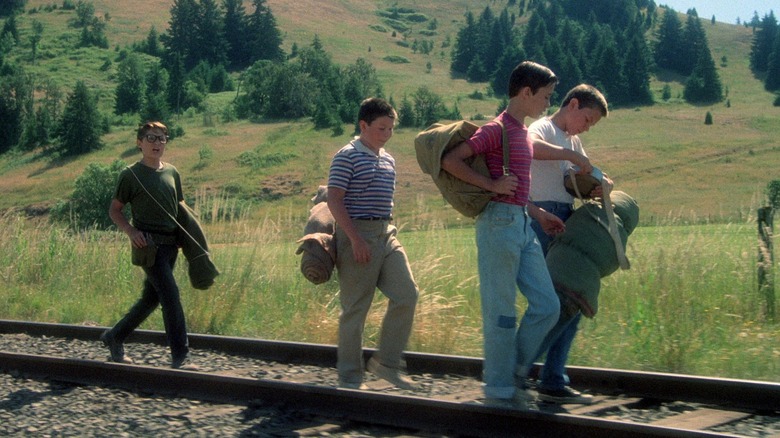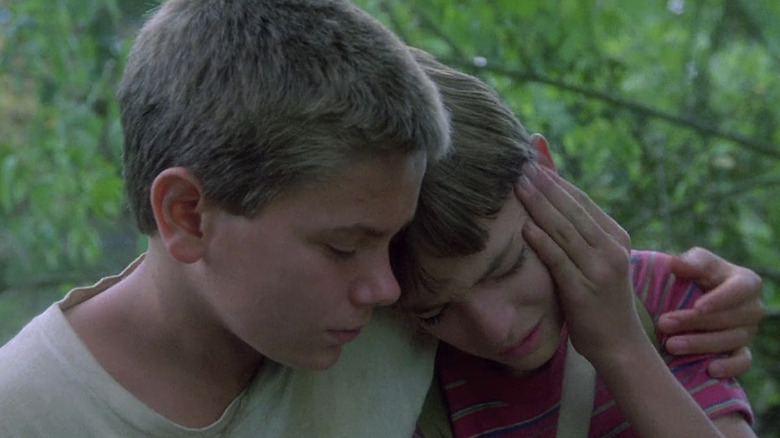The Stephen King Movie Every Studio Turned Down Became A Bona Fide Classic
By the early 1980s, Stephen King was so successful, he had the chance to do something wannabe authors can only dream of: He took a departure from the horror genre that had made him a best-selling novelist, dusted off some old novellas he'd written years before, and put them together in a collection called "Different Seasons." As time quickly proved, these stories weren't just filler, either; three of the pieces would later be adapted into major feature films, including one that every studio turned down before it became a bona fide classic.
The gimmick of the collection is that each story tentatively represents a season of the year. Therefore, "Rita Hayworth and Shawshank Redemption" (the source material for "The Shawshank Redemption") is subtitled "Hope Springs Eternal;" "Apt Pupil," adapted by Bryan Singer in 1998, is "Summer of Corruption;" "The Body," which became Rob Reiner's "Stand By Me," is "Fall from Innocence;" and "The Breathing Method" is "A Winter's Tale," and remains the only one of the bunch without a film adaptation.
Three out of four isn't bad, however, and it's fun to argue about which is the stronger movie between "The Shawshank Redemption" and "Stand By Me" (sorry, "Apt Pupil" fans, I don't think you're winning this one). Of course, the former is an Oscar Best Picture nominee and, if IMDb is anything to go by, the greatest movie ever made. But "Stand By Me" is still regarded as one of the best coming-of-age tales of the '80s, which makes you wonder in hindsight why studios wouldn't touch it.
What happens in Stand By Me, and why didn't studios want it?
Set in 1959 (apart from its modern-day bookends), "Stand By Me" has aged pretty well compared to some '80s coming-of-age movies thanks to its period setting. Four pre-teen boys from dysfunctional families (played beautifully by Will Wheaton, River Phoenix, Corey Feldman, and Jerry O'Connell) set out to see a dead body they've heard about, encountering a junkyard dog, leeches, and a hair-raising skirmish with a train along the way. Also on the trail of the corpse is Ace Merrill (Kiefer Sutherland) and his vicious gang of thugs. The incidents of the journey are entertaining enough, but the real meat-and-potatoes of the film is the complex dynamic between the boys and how they bond during their adventure.
"Stand By Me" is a pretty simple story, but coming-of-age tales often are. (What is "The Breakfast Club" other than a bunch of teens bickering and bonding in detention?) Yet it was this simplicity that initially turned studios off, especially since King's story didn't follow the usual conventions of the genre. As Bruce A. Evans, co-writer and producer, put it (via Variety):
"The consensus was that no one would be interested in a story about four 12-year old boys on a railroad track. It was dark, there was not a girl in it, no one knew how to sell it. Of course, what attracted us to it was that it was a coming-of-age story without girls or buying rubbers or first kisses or all of that. It was about kids becoming aware of their own mortality."
Ultimately, it would take a lesser studio and a director better known as a sitcom star to see the potential and bring "Stand By Me" to the screen.
Stand By Me rewarded the gamble from Embassy Pictures
After co-writers Bruce Evans and Raynold Gideon shopped their adaptation of "The Body" around Hollywood, the only company prepared to take a chance on it was Embassy Pictures. According to Gideon, "[the studio] at the time was the last station before the desert. After that, there was nothing."
Embassy originally lined up Adrian Lyne to direct after he'd had a hit with "9 ½ Weeks," but he decided to give himself a holiday. That might have been a blessing in disguise because the studio, co-owned by Norman Lear of "All in the Family" fame, had the perfect replacement. Rob Reiner, better known for playing Mike "Meathead" Stivic in Lear's sitcom in the '70s, already had two comedies under his belt for the studio: "This is Spinal Tap" and "The Sure Thing." "Stand By Me" gave him a chance to prove his dramatic chops as a director and make the most personal film of his career. And Lear saved the day again when he ponied up $7.5 million out of pocket for the budget when financing fell through at the last minute.
Embassy's gamble on a King story that no other studio wanted make paid off, and eventually Columbia Pictures, which had passed on it originally, came back around and decided to distribute it after River Phoenix earned rave reviews from the head of the studio's daughters during a small screening. "Stand By Me" was a critical and commercial success, and also received an Oscar nomination for Best Adapted Screenplay. Nowadays, it is regarded as not only one of the best coming-of-age movies of all time, but also one of the very best Stephen King adaptations. Turns out that a lot of people really love stories about 12-year-old kids walking along a railway track, after all.


